Leadership in the 21st Century: Modern vs. Traditional Styles Report
VerifiedAdded on 2020/05/16
|14
|3920
|413
Report
AI Summary
This report provides a comprehensive analysis of leadership in the 21st century, delving into its core competencies, including honesty, communication, decision-making, management skills, and problem-solving abilities. It contrasts modern and traditional leadership styles, outlining factors driving the shift, such as technological advancements, cultural changes, and economic conditions. The report identifies key challenges faced by contemporary leaders, including increased competition, performance expectations, skill gaps, and talent retention issues. It also explores the evolution of leadership theories, the meaning of leadership in management contexts, and the relationship between leadership and gender. The report offers insights into the dynamic nature of leadership and the adaptations required for success in the modern business environment.
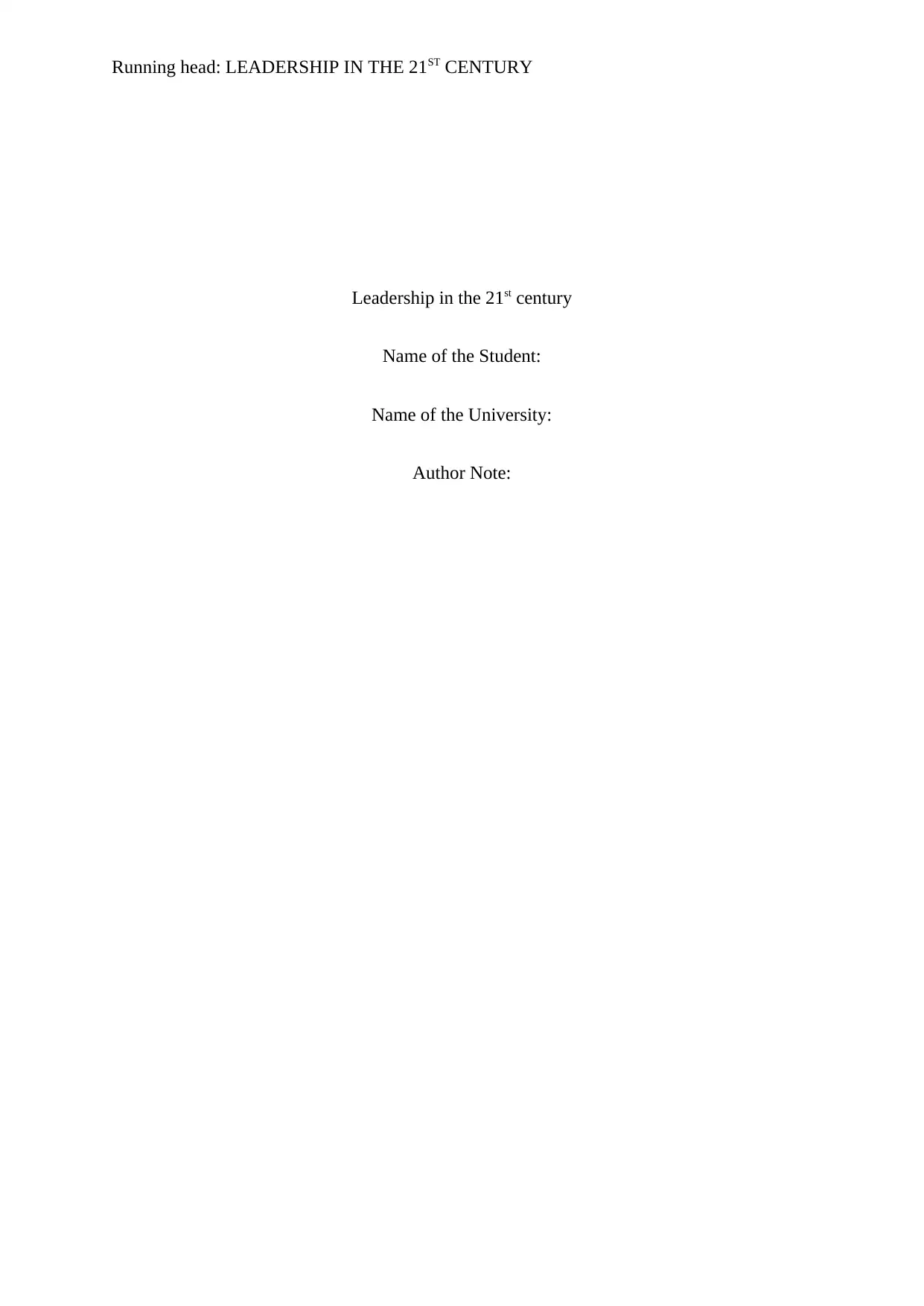
Running head: LEADERSHIP IN THE 21ST CENTURY
Leadership in the 21st century
Name of the Student:
Name of the University:
Author Note:
Leadership in the 21st century
Name of the Student:
Name of the University:
Author Note:
Paraphrase This Document
Need a fresh take? Get an instant paraphrase of this document with our AI Paraphraser
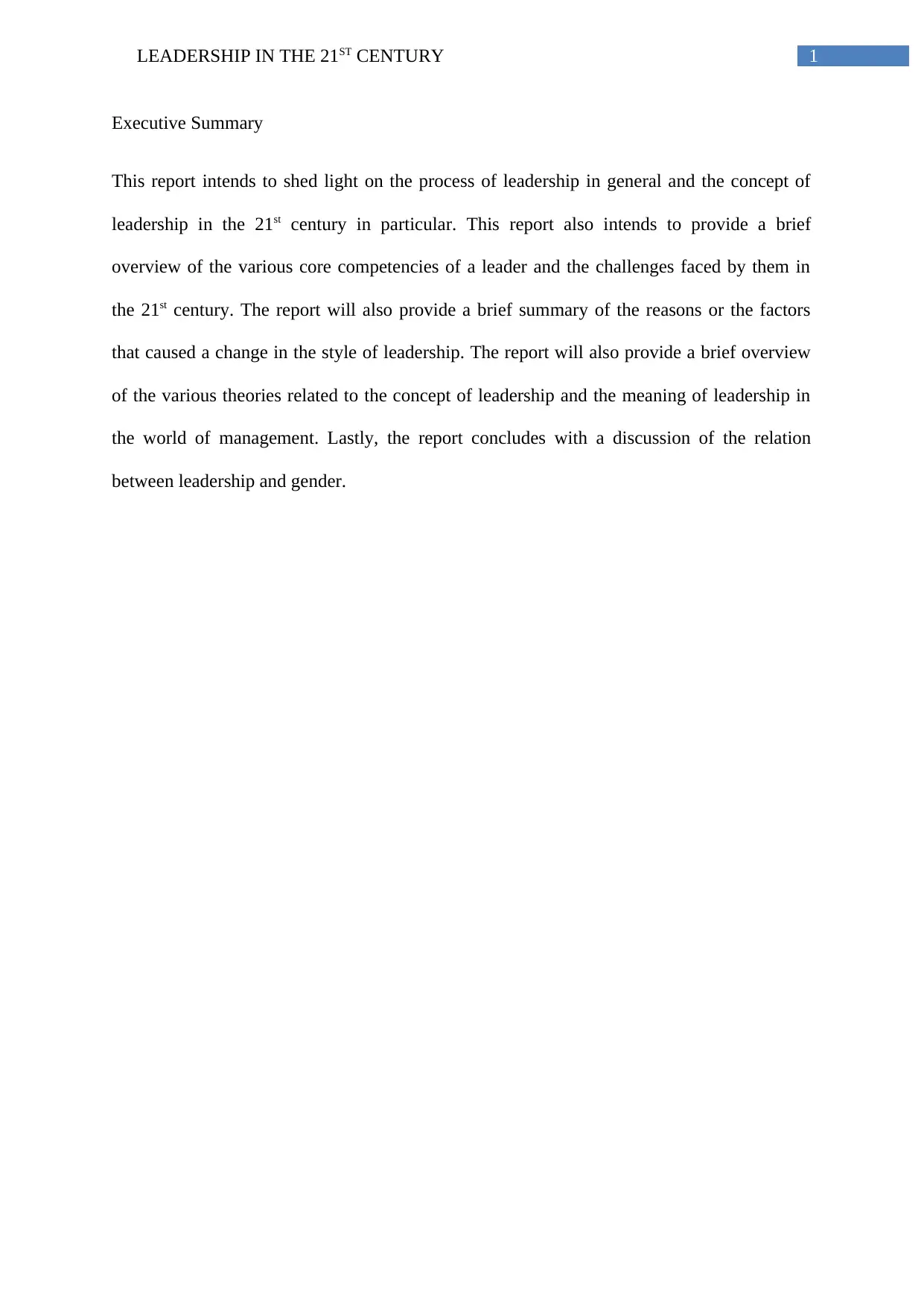
1LEADERSHIP IN THE 21ST CENTURY
Executive Summary
This report intends to shed light on the process of leadership in general and the concept of
leadership in the 21st century in particular. This report also intends to provide a brief
overview of the various core competencies of a leader and the challenges faced by them in
the 21st century. The report will also provide a brief summary of the reasons or the factors
that caused a change in the style of leadership. The report will also provide a brief overview
of the various theories related to the concept of leadership and the meaning of leadership in
the world of management. Lastly, the report concludes with a discussion of the relation
between leadership and gender.
Executive Summary
This report intends to shed light on the process of leadership in general and the concept of
leadership in the 21st century in particular. This report also intends to provide a brief
overview of the various core competencies of a leader and the challenges faced by them in
the 21st century. The report will also provide a brief summary of the reasons or the factors
that caused a change in the style of leadership. The report will also provide a brief overview
of the various theories related to the concept of leadership and the meaning of leadership in
the world of management. Lastly, the report concludes with a discussion of the relation
between leadership and gender.
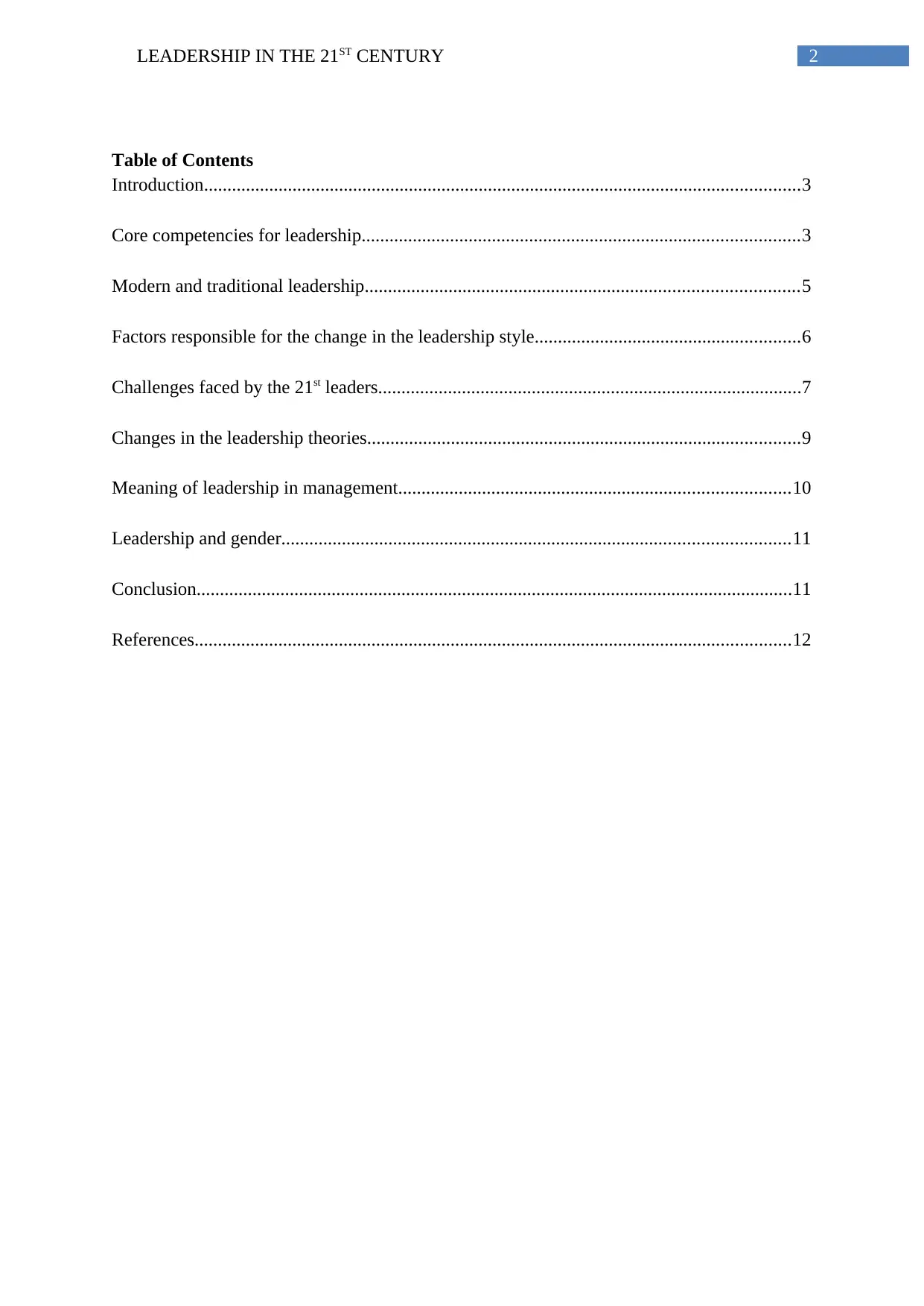
2LEADERSHIP IN THE 21ST CENTURY
Table of Contents
Introduction................................................................................................................................3
Core competencies for leadership..............................................................................................3
Modern and traditional leadership.............................................................................................5
Factors responsible for the change in the leadership style.........................................................6
Challenges faced by the 21st leaders...........................................................................................7
Changes in the leadership theories.............................................................................................9
Meaning of leadership in management....................................................................................10
Leadership and gender.............................................................................................................11
Conclusion................................................................................................................................11
References................................................................................................................................12
Table of Contents
Introduction................................................................................................................................3
Core competencies for leadership..............................................................................................3
Modern and traditional leadership.............................................................................................5
Factors responsible for the change in the leadership style.........................................................6
Challenges faced by the 21st leaders...........................................................................................7
Changes in the leadership theories.............................................................................................9
Meaning of leadership in management....................................................................................10
Leadership and gender.............................................................................................................11
Conclusion................................................................................................................................11
References................................................................................................................................12
⊘ This is a preview!⊘
Do you want full access?
Subscribe today to unlock all pages.

Trusted by 1+ million students worldwide
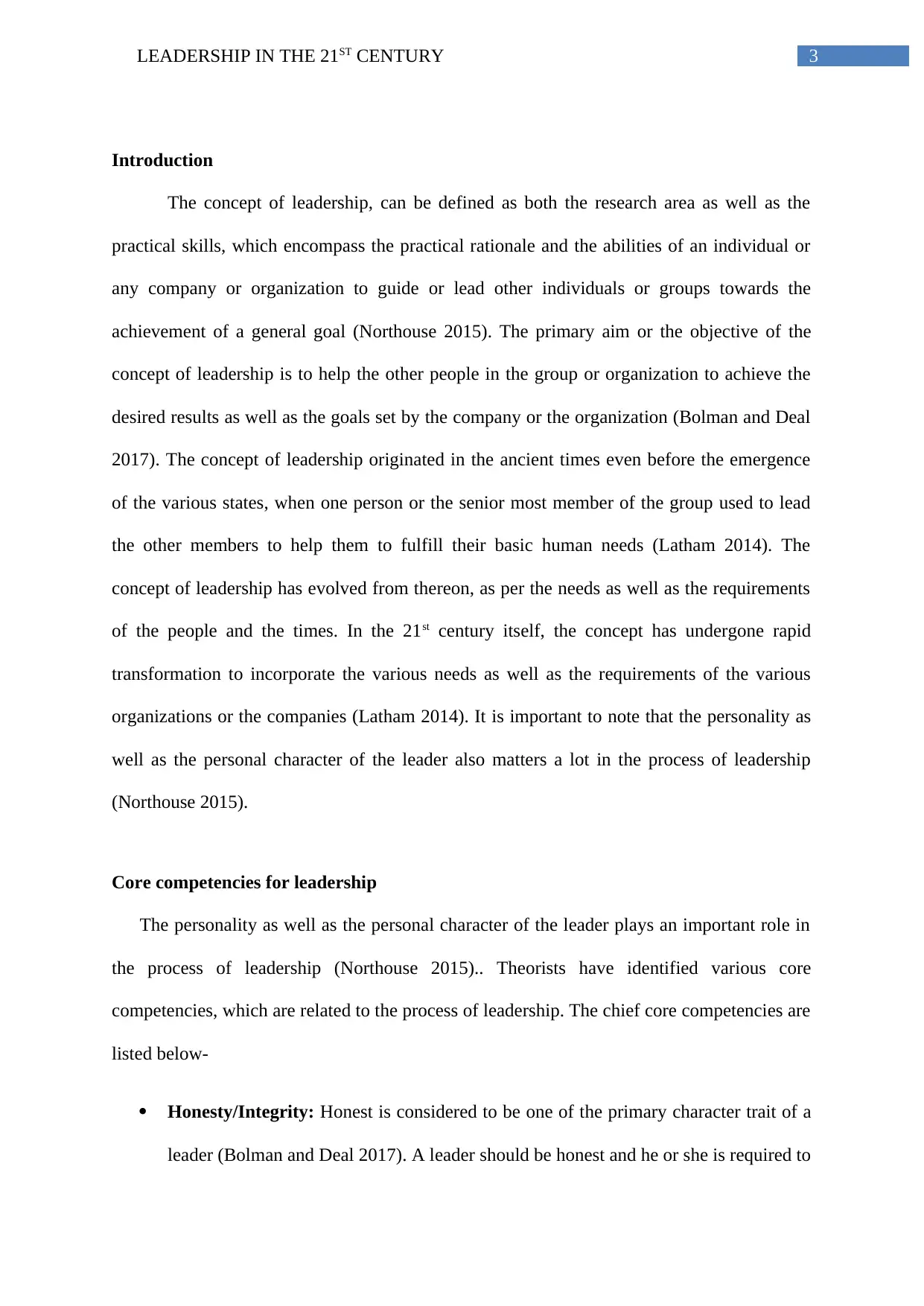
3LEADERSHIP IN THE 21ST CENTURY
Introduction
The concept of leadership, can be defined as both the research area as well as the
practical skills, which encompass the practical rationale and the abilities of an individual or
any company or organization to guide or lead other individuals or groups towards the
achievement of a general goal (Northouse 2015). The primary aim or the objective of the
concept of leadership is to help the other people in the group or organization to achieve the
desired results as well as the goals set by the company or the organization (Bolman and Deal
2017). The concept of leadership originated in the ancient times even before the emergence
of the various states, when one person or the senior most member of the group used to lead
the other members to help them to fulfill their basic human needs (Latham 2014). The
concept of leadership has evolved from thereon, as per the needs as well as the requirements
of the people and the times. In the 21st century itself, the concept has undergone rapid
transformation to incorporate the various needs as well as the requirements of the various
organizations or the companies (Latham 2014). It is important to note that the personality as
well as the personal character of the leader also matters a lot in the process of leadership
(Northouse 2015).
Core competencies for leadership
The personality as well as the personal character of the leader plays an important role in
the process of leadership (Northouse 2015).. Theorists have identified various core
competencies, which are related to the process of leadership. The chief core competencies are
listed below-
Honesty/Integrity: Honest is considered to be one of the primary character trait of a
leader (Bolman and Deal 2017). A leader should be honest and he or she is required to
Introduction
The concept of leadership, can be defined as both the research area as well as the
practical skills, which encompass the practical rationale and the abilities of an individual or
any company or organization to guide or lead other individuals or groups towards the
achievement of a general goal (Northouse 2015). The primary aim or the objective of the
concept of leadership is to help the other people in the group or organization to achieve the
desired results as well as the goals set by the company or the organization (Bolman and Deal
2017). The concept of leadership originated in the ancient times even before the emergence
of the various states, when one person or the senior most member of the group used to lead
the other members to help them to fulfill their basic human needs (Latham 2014). The
concept of leadership has evolved from thereon, as per the needs as well as the requirements
of the people and the times. In the 21st century itself, the concept has undergone rapid
transformation to incorporate the various needs as well as the requirements of the various
organizations or the companies (Latham 2014). It is important to note that the personality as
well as the personal character of the leader also matters a lot in the process of leadership
(Northouse 2015).
Core competencies for leadership
The personality as well as the personal character of the leader plays an important role in
the process of leadership (Northouse 2015).. Theorists have identified various core
competencies, which are related to the process of leadership. The chief core competencies are
listed below-
Honesty/Integrity: Honest is considered to be one of the primary character trait of a
leader (Bolman and Deal 2017). A leader should be honest and he or she is required to
Paraphrase This Document
Need a fresh take? Get an instant paraphrase of this document with our AI Paraphraser
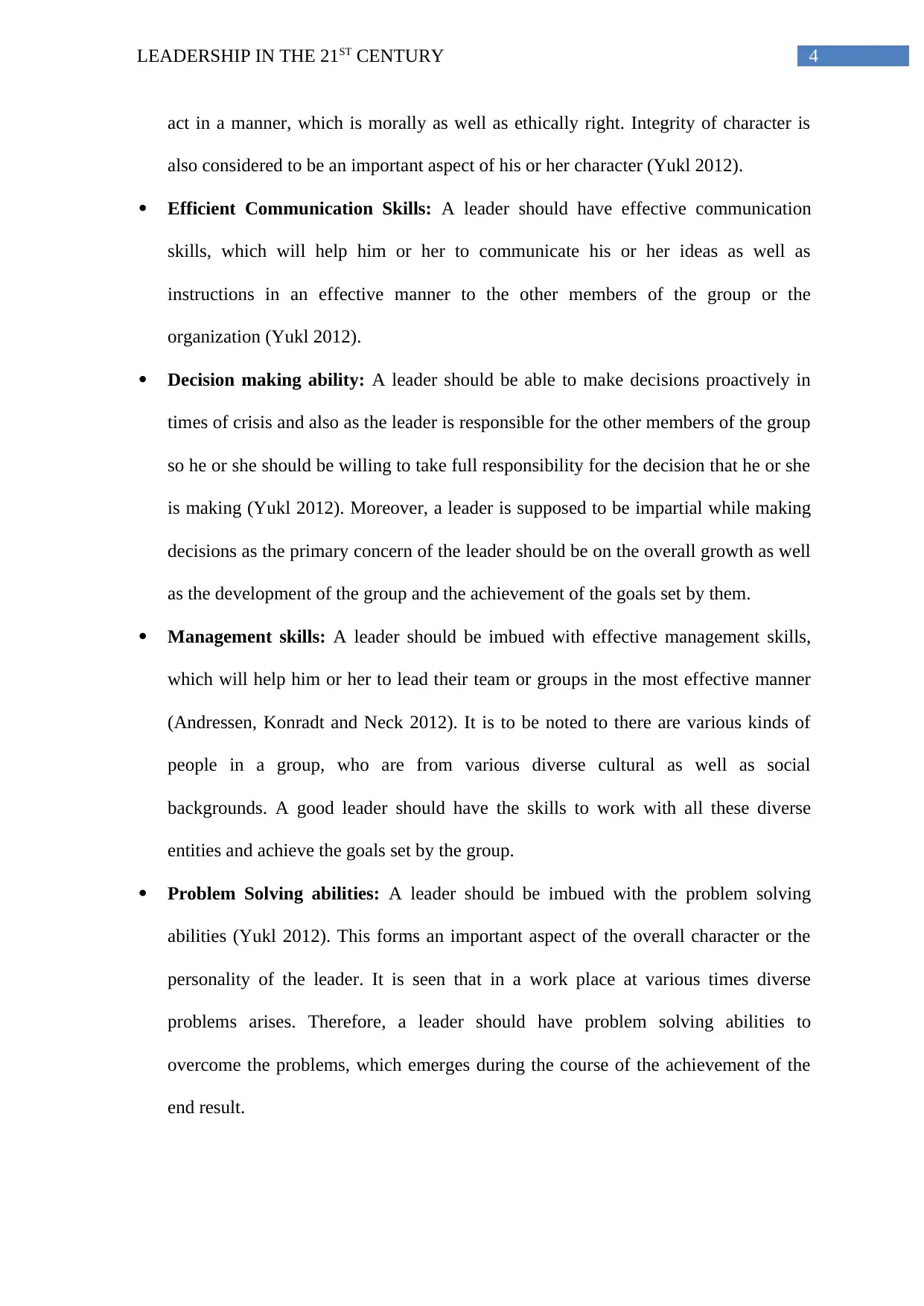
4LEADERSHIP IN THE 21ST CENTURY
act in a manner, which is morally as well as ethically right. Integrity of character is
also considered to be an important aspect of his or her character (Yukl 2012).
Efficient Communication Skills: A leader should have effective communication
skills, which will help him or her to communicate his or her ideas as well as
instructions in an effective manner to the other members of the group or the
organization (Yukl 2012).
Decision making ability: A leader should be able to make decisions proactively in
times of crisis and also as the leader is responsible for the other members of the group
so he or she should be willing to take full responsibility for the decision that he or she
is making (Yukl 2012). Moreover, a leader is supposed to be impartial while making
decisions as the primary concern of the leader should be on the overall growth as well
as the development of the group and the achievement of the goals set by them.
Management skills: A leader should be imbued with effective management skills,
which will help him or her to lead their team or groups in the most effective manner
(Andressen, Konradt and Neck 2012). It is to be noted to there are various kinds of
people in a group, who are from various diverse cultural as well as social
backgrounds. A good leader should have the skills to work with all these diverse
entities and achieve the goals set by the group.
Problem Solving abilities: A leader should be imbued with the problem solving
abilities (Yukl 2012). This forms an important aspect of the overall character or the
personality of the leader. It is seen that in a work place at various times diverse
problems arises. Therefore, a leader should have problem solving abilities to
overcome the problems, which emerges during the course of the achievement of the
end result.
act in a manner, which is morally as well as ethically right. Integrity of character is
also considered to be an important aspect of his or her character (Yukl 2012).
Efficient Communication Skills: A leader should have effective communication
skills, which will help him or her to communicate his or her ideas as well as
instructions in an effective manner to the other members of the group or the
organization (Yukl 2012).
Decision making ability: A leader should be able to make decisions proactively in
times of crisis and also as the leader is responsible for the other members of the group
so he or she should be willing to take full responsibility for the decision that he or she
is making (Yukl 2012). Moreover, a leader is supposed to be impartial while making
decisions as the primary concern of the leader should be on the overall growth as well
as the development of the group and the achievement of the goals set by them.
Management skills: A leader should be imbued with effective management skills,
which will help him or her to lead their team or groups in the most effective manner
(Andressen, Konradt and Neck 2012). It is to be noted to there are various kinds of
people in a group, who are from various diverse cultural as well as social
backgrounds. A good leader should have the skills to work with all these diverse
entities and achieve the goals set by the group.
Problem Solving abilities: A leader should be imbued with the problem solving
abilities (Yukl 2012). This forms an important aspect of the overall character or the
personality of the leader. It is seen that in a work place at various times diverse
problems arises. Therefore, a leader should have problem solving abilities to
overcome the problems, which emerges during the course of the achievement of the
end result.
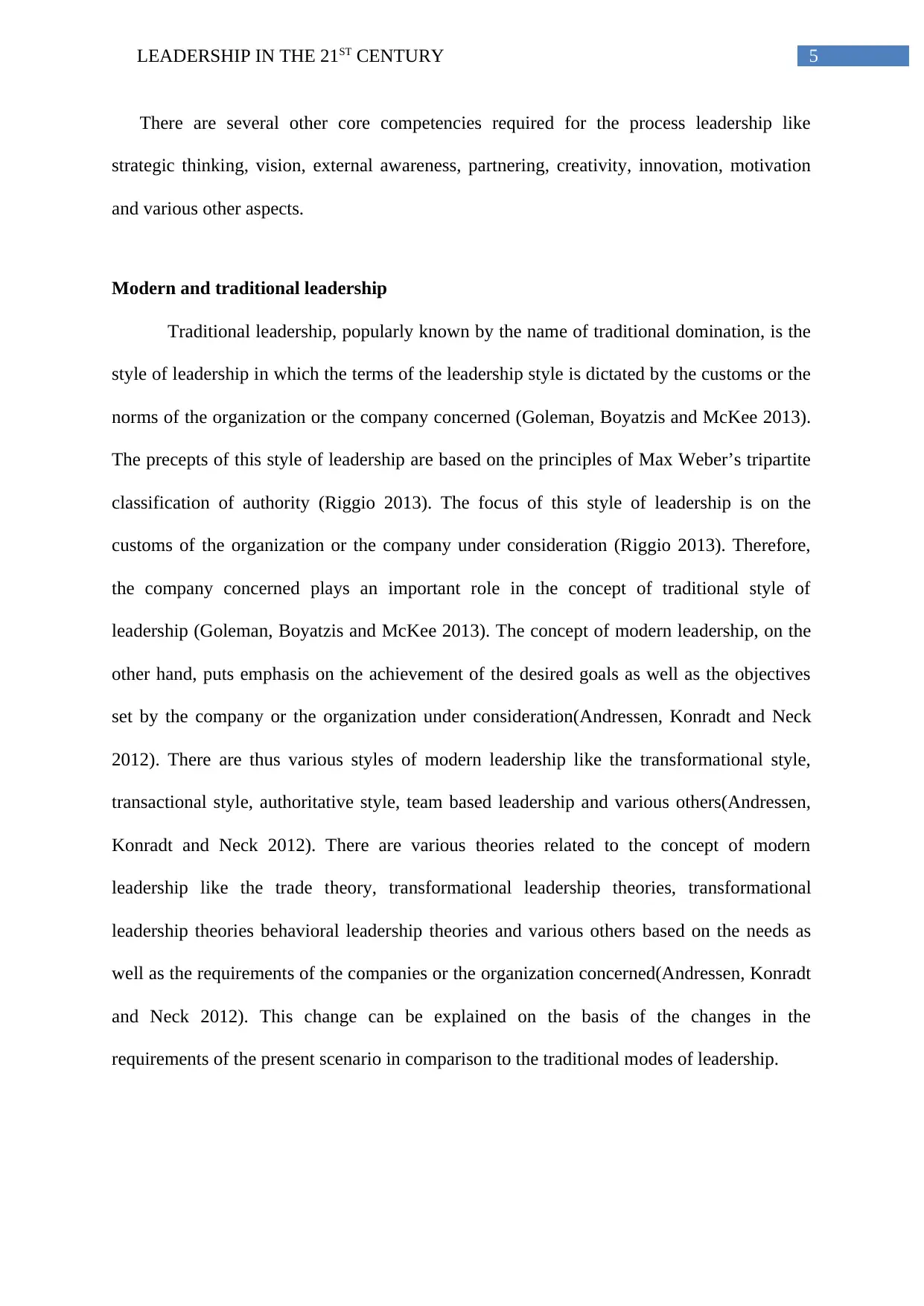
5LEADERSHIP IN THE 21ST CENTURY
There are several other core competencies required for the process leadership like
strategic thinking, vision, external awareness, partnering, creativity, innovation, motivation
and various other aspects.
Modern and traditional leadership
Traditional leadership, popularly known by the name of traditional domination, is the
style of leadership in which the terms of the leadership style is dictated by the customs or the
norms of the organization or the company concerned (Goleman, Boyatzis and McKee 2013).
The precepts of this style of leadership are based on the principles of Max Weber’s tripartite
classification of authority (Riggio 2013). The focus of this style of leadership is on the
customs of the organization or the company under consideration (Riggio 2013). Therefore,
the company concerned plays an important role in the concept of traditional style of
leadership (Goleman, Boyatzis and McKee 2013). The concept of modern leadership, on the
other hand, puts emphasis on the achievement of the desired goals as well as the objectives
set by the company or the organization under consideration(Andressen, Konradt and Neck
2012). There are thus various styles of modern leadership like the transformational style,
transactional style, authoritative style, team based leadership and various others(Andressen,
Konradt and Neck 2012). There are various theories related to the concept of modern
leadership like the trade theory, transformational leadership theories, transformational
leadership theories behavioral leadership theories and various others based on the needs as
well as the requirements of the companies or the organization concerned(Andressen, Konradt
and Neck 2012). This change can be explained on the basis of the changes in the
requirements of the present scenario in comparison to the traditional modes of leadership.
There are several other core competencies required for the process leadership like
strategic thinking, vision, external awareness, partnering, creativity, innovation, motivation
and various other aspects.
Modern and traditional leadership
Traditional leadership, popularly known by the name of traditional domination, is the
style of leadership in which the terms of the leadership style is dictated by the customs or the
norms of the organization or the company concerned (Goleman, Boyatzis and McKee 2013).
The precepts of this style of leadership are based on the principles of Max Weber’s tripartite
classification of authority (Riggio 2013). The focus of this style of leadership is on the
customs of the organization or the company under consideration (Riggio 2013). Therefore,
the company concerned plays an important role in the concept of traditional style of
leadership (Goleman, Boyatzis and McKee 2013). The concept of modern leadership, on the
other hand, puts emphasis on the achievement of the desired goals as well as the objectives
set by the company or the organization under consideration(Andressen, Konradt and Neck
2012). There are thus various styles of modern leadership like the transformational style,
transactional style, authoritative style, team based leadership and various others(Andressen,
Konradt and Neck 2012). There are various theories related to the concept of modern
leadership like the trade theory, transformational leadership theories, transformational
leadership theories behavioral leadership theories and various others based on the needs as
well as the requirements of the companies or the organization concerned(Andressen, Konradt
and Neck 2012). This change can be explained on the basis of the changes in the
requirements of the present scenario in comparison to the traditional modes of leadership.
⊘ This is a preview!⊘
Do you want full access?
Subscribe today to unlock all pages.

Trusted by 1+ million students worldwide
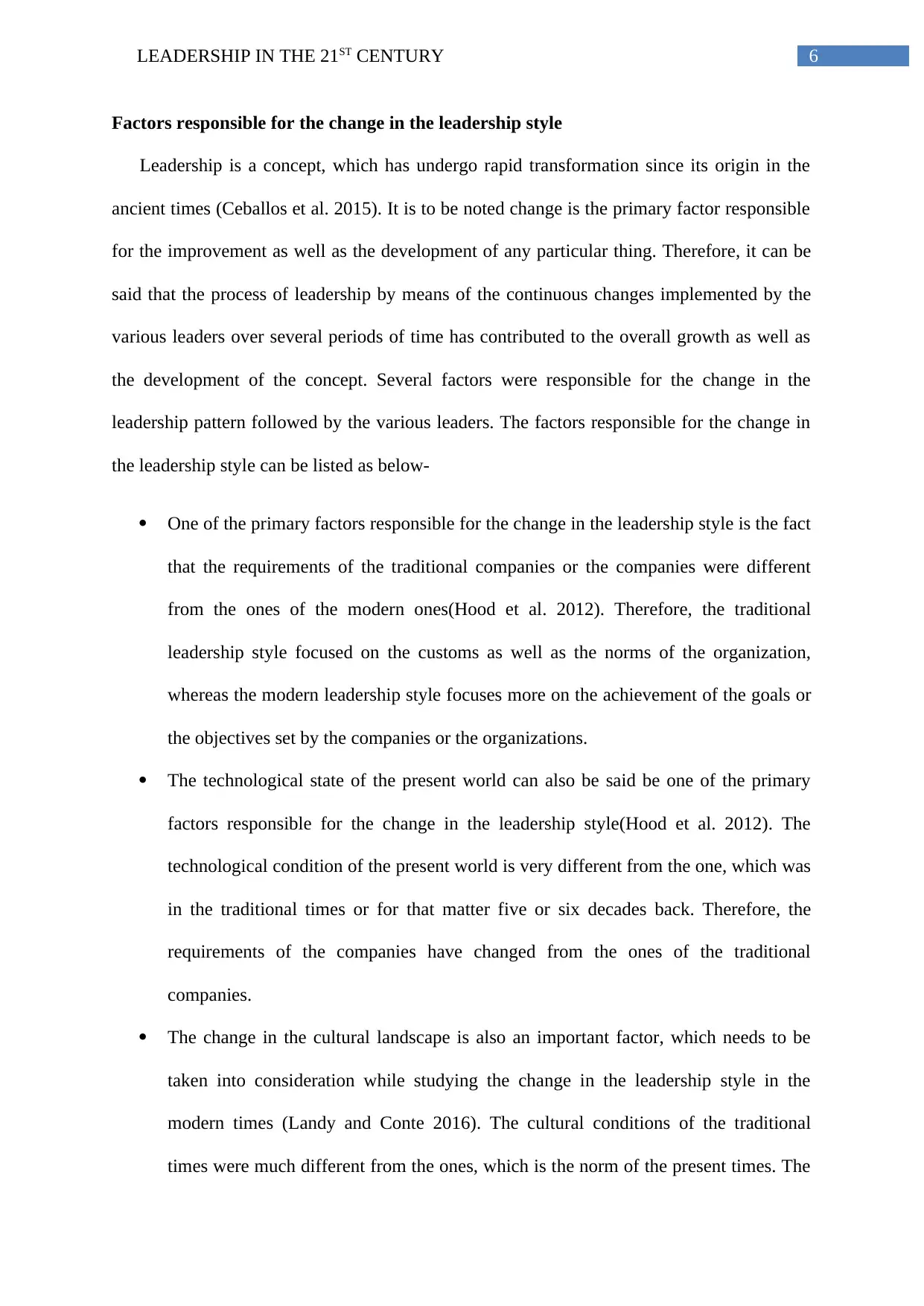
6LEADERSHIP IN THE 21ST CENTURY
Factors responsible for the change in the leadership style
Leadership is a concept, which has undergo rapid transformation since its origin in the
ancient times (Ceballos et al. 2015). It is to be noted change is the primary factor responsible
for the improvement as well as the development of any particular thing. Therefore, it can be
said that the process of leadership by means of the continuous changes implemented by the
various leaders over several periods of time has contributed to the overall growth as well as
the development of the concept. Several factors were responsible for the change in the
leadership pattern followed by the various leaders. The factors responsible for the change in
the leadership style can be listed as below-
One of the primary factors responsible for the change in the leadership style is the fact
that the requirements of the traditional companies or the companies were different
from the ones of the modern ones(Hood et al. 2012). Therefore, the traditional
leadership style focused on the customs as well as the norms of the organization,
whereas the modern leadership style focuses more on the achievement of the goals or
the objectives set by the companies or the organizations.
The technological state of the present world can also be said be one of the primary
factors responsible for the change in the leadership style(Hood et al. 2012). The
technological condition of the present world is very different from the one, which was
in the traditional times or for that matter five or six decades back. Therefore, the
requirements of the companies have changed from the ones of the traditional
companies.
The change in the cultural landscape is also an important factor, which needs to be
taken into consideration while studying the change in the leadership style in the
modern times (Landy and Conte 2016). The cultural conditions of the traditional
times were much different from the ones, which is the norm of the present times. The
Factors responsible for the change in the leadership style
Leadership is a concept, which has undergo rapid transformation since its origin in the
ancient times (Ceballos et al. 2015). It is to be noted change is the primary factor responsible
for the improvement as well as the development of any particular thing. Therefore, it can be
said that the process of leadership by means of the continuous changes implemented by the
various leaders over several periods of time has contributed to the overall growth as well as
the development of the concept. Several factors were responsible for the change in the
leadership pattern followed by the various leaders. The factors responsible for the change in
the leadership style can be listed as below-
One of the primary factors responsible for the change in the leadership style is the fact
that the requirements of the traditional companies or the companies were different
from the ones of the modern ones(Hood et al. 2012). Therefore, the traditional
leadership style focused on the customs as well as the norms of the organization,
whereas the modern leadership style focuses more on the achievement of the goals or
the objectives set by the companies or the organizations.
The technological state of the present world can also be said be one of the primary
factors responsible for the change in the leadership style(Hood et al. 2012). The
technological condition of the present world is very different from the one, which was
in the traditional times or for that matter five or six decades back. Therefore, the
requirements of the companies have changed from the ones of the traditional
companies.
The change in the cultural landscape is also an important factor, which needs to be
taken into consideration while studying the change in the leadership style in the
modern times (Landy and Conte 2016). The cultural conditions of the traditional
times were much different from the ones, which is the norm of the present times. The
Paraphrase This Document
Need a fresh take? Get an instant paraphrase of this document with our AI Paraphraser
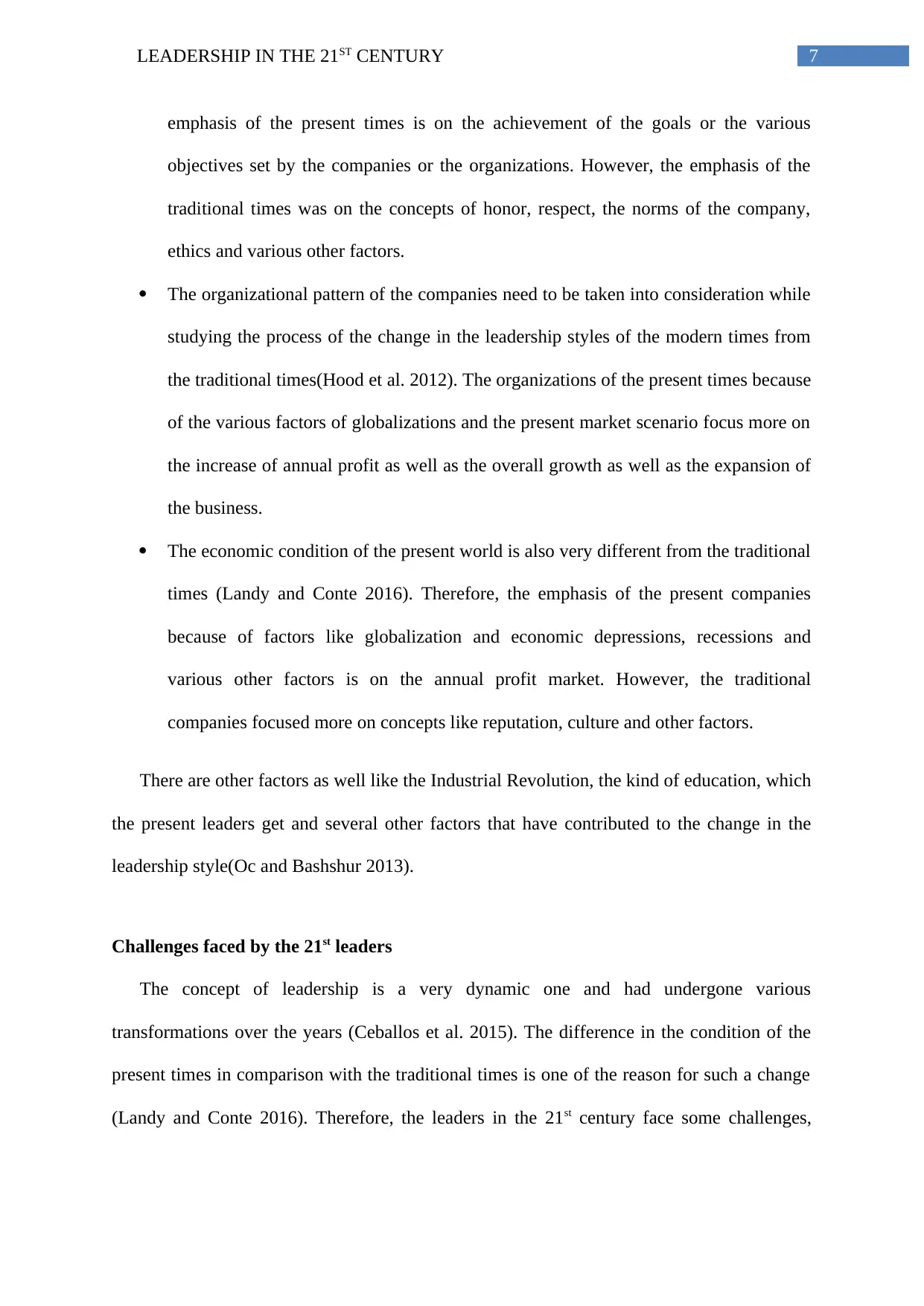
7LEADERSHIP IN THE 21ST CENTURY
emphasis of the present times is on the achievement of the goals or the various
objectives set by the companies or the organizations. However, the emphasis of the
traditional times was on the concepts of honor, respect, the norms of the company,
ethics and various other factors.
The organizational pattern of the companies need to be taken into consideration while
studying the process of the change in the leadership styles of the modern times from
the traditional times(Hood et al. 2012). The organizations of the present times because
of the various factors of globalizations and the present market scenario focus more on
the increase of annual profit as well as the overall growth as well as the expansion of
the business.
The economic condition of the present world is also very different from the traditional
times (Landy and Conte 2016). Therefore, the emphasis of the present companies
because of factors like globalization and economic depressions, recessions and
various other factors is on the annual profit market. However, the traditional
companies focused more on concepts like reputation, culture and other factors.
There are other factors as well like the Industrial Revolution, the kind of education, which
the present leaders get and several other factors that have contributed to the change in the
leadership style(Oc and Bashshur 2013).
Challenges faced by the 21st leaders
The concept of leadership is a very dynamic one and had undergone various
transformations over the years (Ceballos et al. 2015). The difference in the condition of the
present times in comparison with the traditional times is one of the reason for such a change
(Landy and Conte 2016). Therefore, the leaders in the 21st century face some challenges,
emphasis of the present times is on the achievement of the goals or the various
objectives set by the companies or the organizations. However, the emphasis of the
traditional times was on the concepts of honor, respect, the norms of the company,
ethics and various other factors.
The organizational pattern of the companies need to be taken into consideration while
studying the process of the change in the leadership styles of the modern times from
the traditional times(Hood et al. 2012). The organizations of the present times because
of the various factors of globalizations and the present market scenario focus more on
the increase of annual profit as well as the overall growth as well as the expansion of
the business.
The economic condition of the present world is also very different from the traditional
times (Landy and Conte 2016). Therefore, the emphasis of the present companies
because of factors like globalization and economic depressions, recessions and
various other factors is on the annual profit market. However, the traditional
companies focused more on concepts like reputation, culture and other factors.
There are other factors as well like the Industrial Revolution, the kind of education, which
the present leaders get and several other factors that have contributed to the change in the
leadership style(Oc and Bashshur 2013).
Challenges faced by the 21st leaders
The concept of leadership is a very dynamic one and had undergone various
transformations over the years (Ceballos et al. 2015). The difference in the condition of the
present times in comparison with the traditional times is one of the reason for such a change
(Landy and Conte 2016). Therefore, the leaders in the 21st century face some challenges,
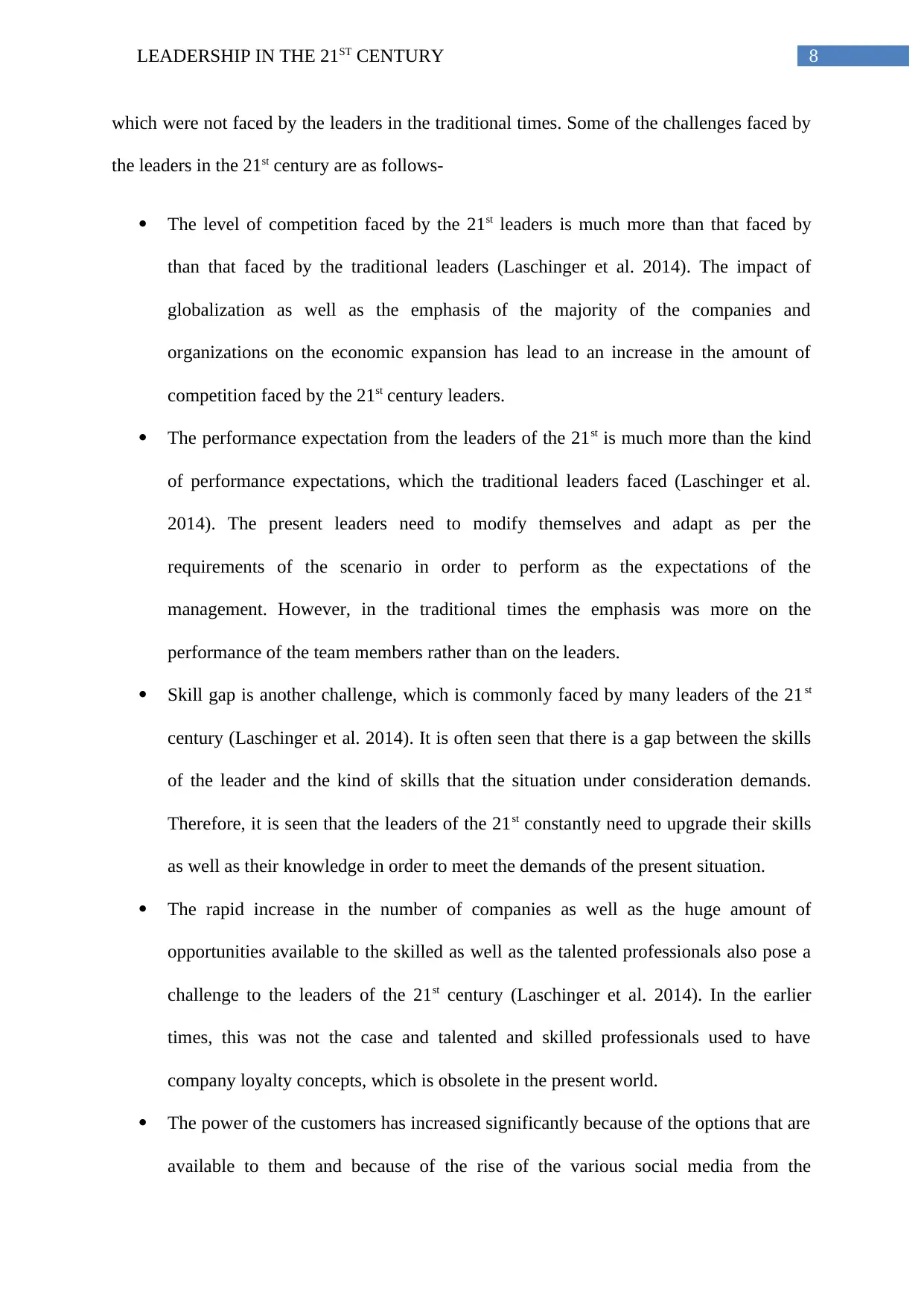
8LEADERSHIP IN THE 21ST CENTURY
which were not faced by the leaders in the traditional times. Some of the challenges faced by
the leaders in the 21st century are as follows-
The level of competition faced by the 21st leaders is much more than that faced by
than that faced by the traditional leaders (Laschinger et al. 2014). The impact of
globalization as well as the emphasis of the majority of the companies and
organizations on the economic expansion has lead to an increase in the amount of
competition faced by the 21st century leaders.
The performance expectation from the leaders of the 21st is much more than the kind
of performance expectations, which the traditional leaders faced (Laschinger et al.
2014). The present leaders need to modify themselves and adapt as per the
requirements of the scenario in order to perform as the expectations of the
management. However, in the traditional times the emphasis was more on the
performance of the team members rather than on the leaders.
Skill gap is another challenge, which is commonly faced by many leaders of the 21st
century (Laschinger et al. 2014). It is often seen that there is a gap between the skills
of the leader and the kind of skills that the situation under consideration demands.
Therefore, it is seen that the leaders of the 21st constantly need to upgrade their skills
as well as their knowledge in order to meet the demands of the present situation.
The rapid increase in the number of companies as well as the huge amount of
opportunities available to the skilled as well as the talented professionals also pose a
challenge to the leaders of the 21st century (Laschinger et al. 2014). In the earlier
times, this was not the case and talented and skilled professionals used to have
company loyalty concepts, which is obsolete in the present world.
The power of the customers has increased significantly because of the options that are
available to them and because of the rise of the various social media from the
which were not faced by the leaders in the traditional times. Some of the challenges faced by
the leaders in the 21st century are as follows-
The level of competition faced by the 21st leaders is much more than that faced by
than that faced by the traditional leaders (Laschinger et al. 2014). The impact of
globalization as well as the emphasis of the majority of the companies and
organizations on the economic expansion has lead to an increase in the amount of
competition faced by the 21st century leaders.
The performance expectation from the leaders of the 21st is much more than the kind
of performance expectations, which the traditional leaders faced (Laschinger et al.
2014). The present leaders need to modify themselves and adapt as per the
requirements of the scenario in order to perform as the expectations of the
management. However, in the traditional times the emphasis was more on the
performance of the team members rather than on the leaders.
Skill gap is another challenge, which is commonly faced by many leaders of the 21st
century (Laschinger et al. 2014). It is often seen that there is a gap between the skills
of the leader and the kind of skills that the situation under consideration demands.
Therefore, it is seen that the leaders of the 21st constantly need to upgrade their skills
as well as their knowledge in order to meet the demands of the present situation.
The rapid increase in the number of companies as well as the huge amount of
opportunities available to the skilled as well as the talented professionals also pose a
challenge to the leaders of the 21st century (Laschinger et al. 2014). In the earlier
times, this was not the case and talented and skilled professionals used to have
company loyalty concepts, which is obsolete in the present world.
The power of the customers has increased significantly because of the options that are
available to them and because of the rise of the various social media from the
⊘ This is a preview!⊘
Do you want full access?
Subscribe today to unlock all pages.

Trusted by 1+ million students worldwide
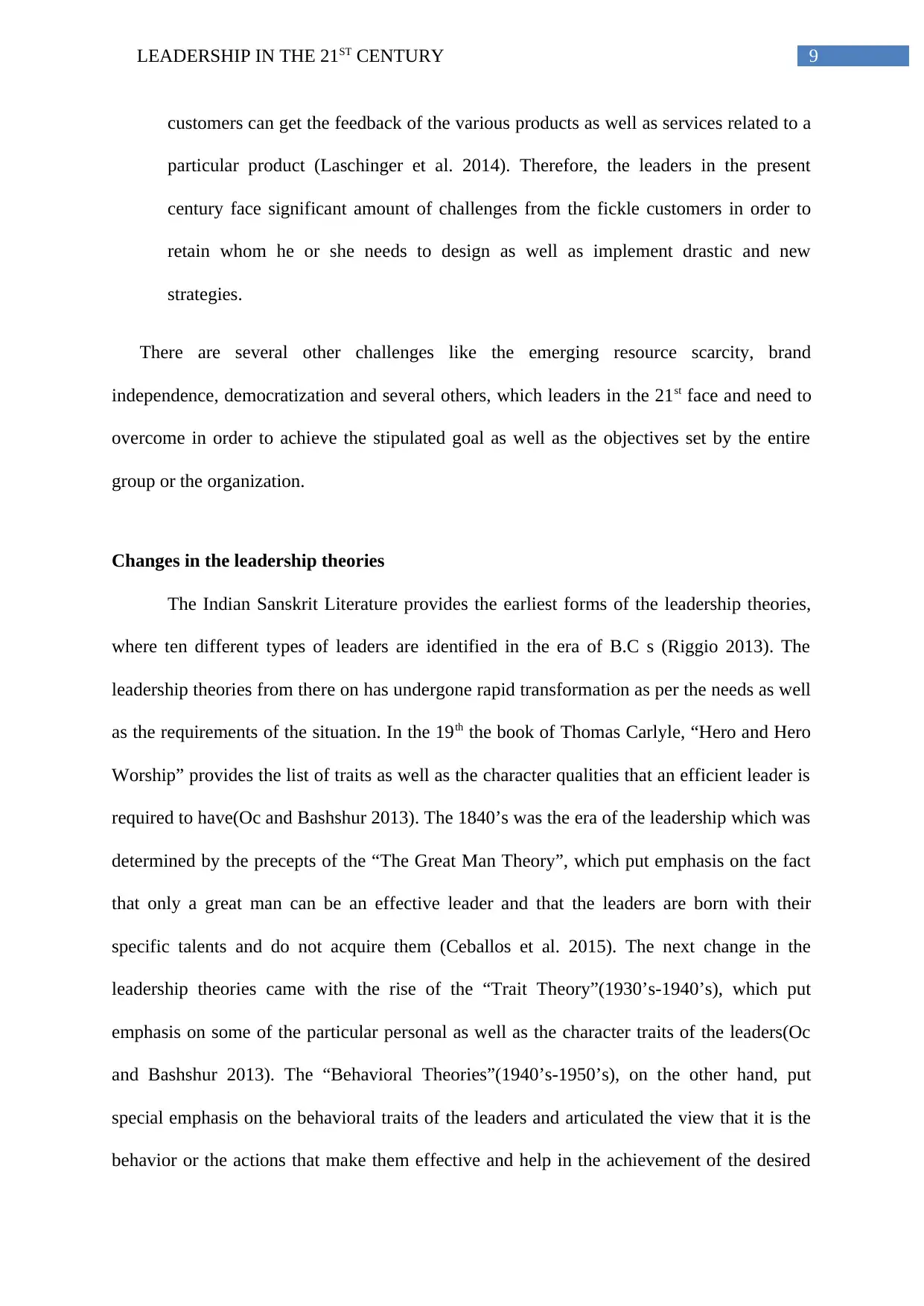
9LEADERSHIP IN THE 21ST CENTURY
customers can get the feedback of the various products as well as services related to a
particular product (Laschinger et al. 2014). Therefore, the leaders in the present
century face significant amount of challenges from the fickle customers in order to
retain whom he or she needs to design as well as implement drastic and new
strategies.
There are several other challenges like the emerging resource scarcity, brand
independence, democratization and several others, which leaders in the 21st face and need to
overcome in order to achieve the stipulated goal as well as the objectives set by the entire
group or the organization.
Changes in the leadership theories
The Indian Sanskrit Literature provides the earliest forms of the leadership theories,
where ten different types of leaders are identified in the era of B.C s (Riggio 2013). The
leadership theories from there on has undergone rapid transformation as per the needs as well
as the requirements of the situation. In the 19th the book of Thomas Carlyle, “Hero and Hero
Worship” provides the list of traits as well as the character qualities that an efficient leader is
required to have(Oc and Bashshur 2013). The 1840’s was the era of the leadership which was
determined by the precepts of the “The Great Man Theory”, which put emphasis on the fact
that only a great man can be an effective leader and that the leaders are born with their
specific talents and do not acquire them (Ceballos et al. 2015). The next change in the
leadership theories came with the rise of the “Trait Theory”(1930’s-1940’s), which put
emphasis on some of the particular personal as well as the character traits of the leaders(Oc
and Bashshur 2013). The “Behavioral Theories”(1940’s-1950’s), on the other hand, put
special emphasis on the behavioral traits of the leaders and articulated the view that it is the
behavior or the actions that make them effective and help in the achievement of the desired
customers can get the feedback of the various products as well as services related to a
particular product (Laschinger et al. 2014). Therefore, the leaders in the present
century face significant amount of challenges from the fickle customers in order to
retain whom he or she needs to design as well as implement drastic and new
strategies.
There are several other challenges like the emerging resource scarcity, brand
independence, democratization and several others, which leaders in the 21st face and need to
overcome in order to achieve the stipulated goal as well as the objectives set by the entire
group or the organization.
Changes in the leadership theories
The Indian Sanskrit Literature provides the earliest forms of the leadership theories,
where ten different types of leaders are identified in the era of B.C s (Riggio 2013). The
leadership theories from there on has undergone rapid transformation as per the needs as well
as the requirements of the situation. In the 19th the book of Thomas Carlyle, “Hero and Hero
Worship” provides the list of traits as well as the character qualities that an efficient leader is
required to have(Oc and Bashshur 2013). The 1840’s was the era of the leadership which was
determined by the precepts of the “The Great Man Theory”, which put emphasis on the fact
that only a great man can be an effective leader and that the leaders are born with their
specific talents and do not acquire them (Ceballos et al. 2015). The next change in the
leadership theories came with the rise of the “Trait Theory”(1930’s-1940’s), which put
emphasis on some of the particular personal as well as the character traits of the leaders(Oc
and Bashshur 2013). The “Behavioral Theories”(1940’s-1950’s), on the other hand, put
special emphasis on the behavioral traits of the leaders and articulated the view that it is the
behavior or the actions that make them effective and help in the achievement of the desired
Paraphrase This Document
Need a fresh take? Get an instant paraphrase of this document with our AI Paraphraser
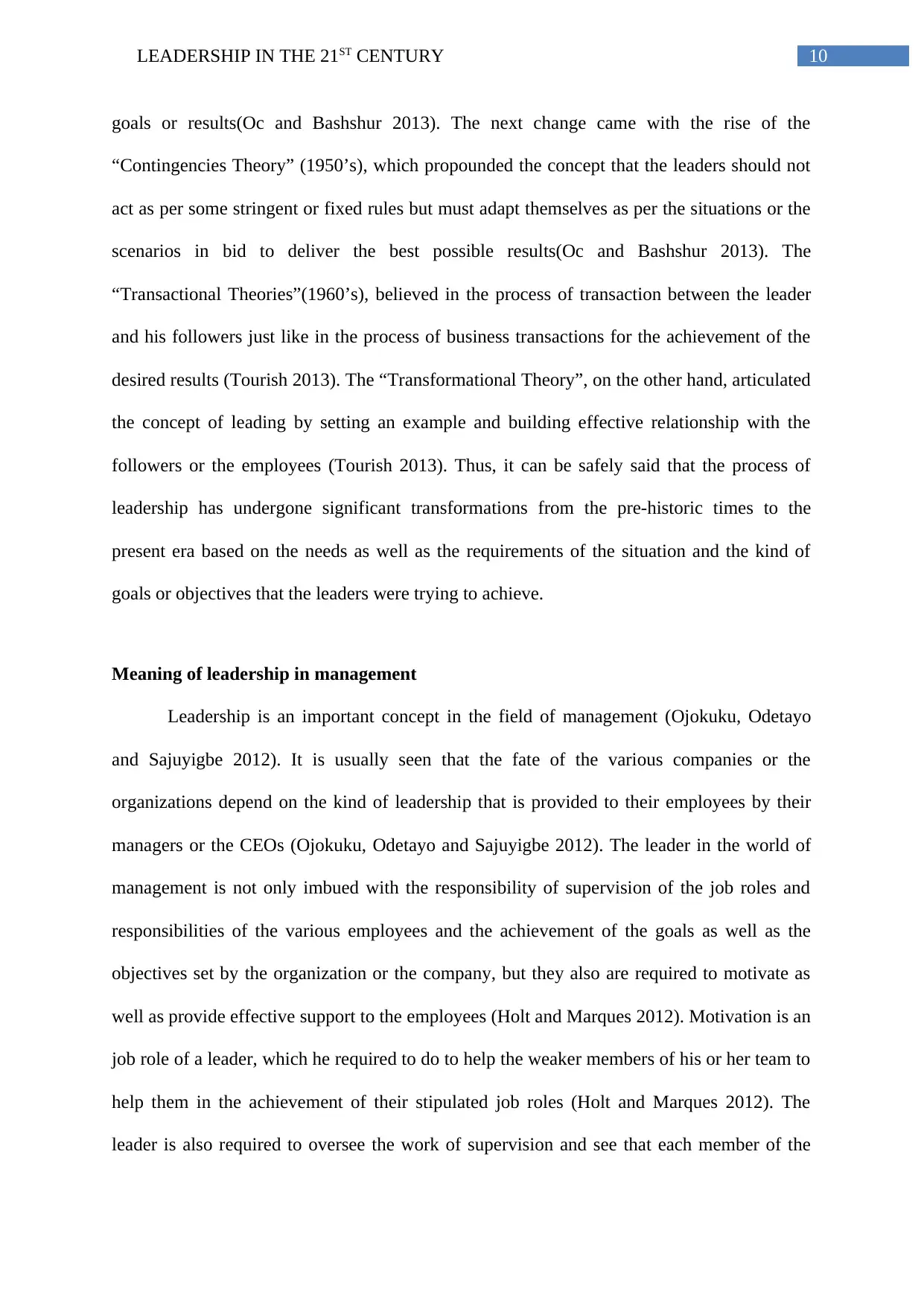
10LEADERSHIP IN THE 21ST CENTURY
goals or results(Oc and Bashshur 2013). The next change came with the rise of the
“Contingencies Theory” (1950’s), which propounded the concept that the leaders should not
act as per some stringent or fixed rules but must adapt themselves as per the situations or the
scenarios in bid to deliver the best possible results(Oc and Bashshur 2013). The
“Transactional Theories”(1960’s), believed in the process of transaction between the leader
and his followers just like in the process of business transactions for the achievement of the
desired results (Tourish 2013). The “Transformational Theory”, on the other hand, articulated
the concept of leading by setting an example and building effective relationship with the
followers or the employees (Tourish 2013). Thus, it can be safely said that the process of
leadership has undergone significant transformations from the pre-historic times to the
present era based on the needs as well as the requirements of the situation and the kind of
goals or objectives that the leaders were trying to achieve.
Meaning of leadership in management
Leadership is an important concept in the field of management (Ojokuku, Odetayo
and Sajuyigbe 2012). It is usually seen that the fate of the various companies or the
organizations depend on the kind of leadership that is provided to their employees by their
managers or the CEOs (Ojokuku, Odetayo and Sajuyigbe 2012). The leader in the world of
management is not only imbued with the responsibility of supervision of the job roles and
responsibilities of the various employees and the achievement of the goals as well as the
objectives set by the organization or the company, but they also are required to motivate as
well as provide effective support to the employees (Holt and Marques 2012). Motivation is an
job role of a leader, which he required to do to help the weaker members of his or her team to
help them in the achievement of their stipulated job roles (Holt and Marques 2012). The
leader is also required to oversee the work of supervision and see that each member of the
goals or results(Oc and Bashshur 2013). The next change came with the rise of the
“Contingencies Theory” (1950’s), which propounded the concept that the leaders should not
act as per some stringent or fixed rules but must adapt themselves as per the situations or the
scenarios in bid to deliver the best possible results(Oc and Bashshur 2013). The
“Transactional Theories”(1960’s), believed in the process of transaction between the leader
and his followers just like in the process of business transactions for the achievement of the
desired results (Tourish 2013). The “Transformational Theory”, on the other hand, articulated
the concept of leading by setting an example and building effective relationship with the
followers or the employees (Tourish 2013). Thus, it can be safely said that the process of
leadership has undergone significant transformations from the pre-historic times to the
present era based on the needs as well as the requirements of the situation and the kind of
goals or objectives that the leaders were trying to achieve.
Meaning of leadership in management
Leadership is an important concept in the field of management (Ojokuku, Odetayo
and Sajuyigbe 2012). It is usually seen that the fate of the various companies or the
organizations depend on the kind of leadership that is provided to their employees by their
managers or the CEOs (Ojokuku, Odetayo and Sajuyigbe 2012). The leader in the world of
management is not only imbued with the responsibility of supervision of the job roles and
responsibilities of the various employees and the achievement of the goals as well as the
objectives set by the organization or the company, but they also are required to motivate as
well as provide effective support to the employees (Holt and Marques 2012). Motivation is an
job role of a leader, which he required to do to help the weaker members of his or her team to
help them in the achievement of their stipulated job roles (Holt and Marques 2012). The
leader is also required to oversee the work of supervision and see that each member of the
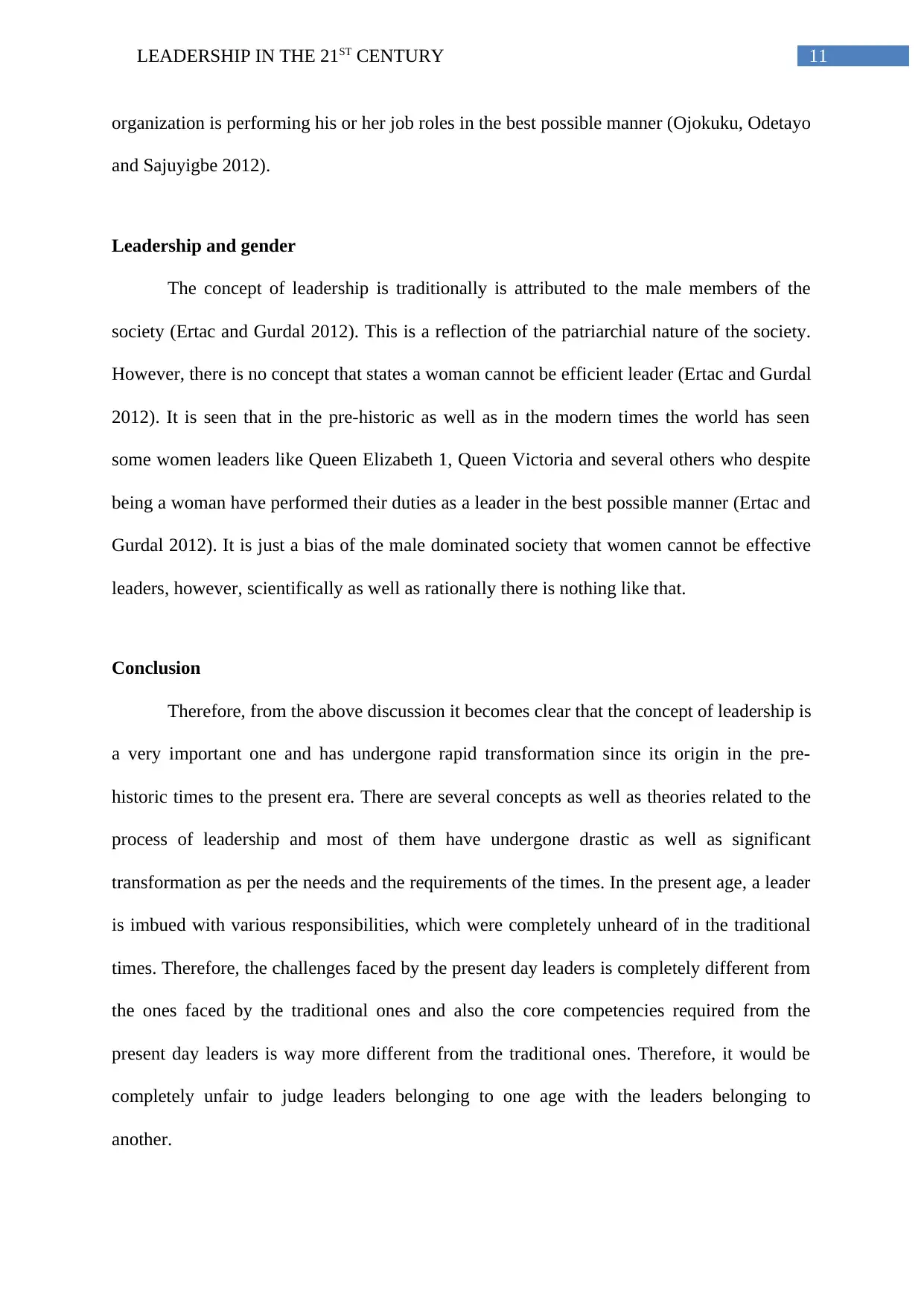
11LEADERSHIP IN THE 21ST CENTURY
organization is performing his or her job roles in the best possible manner (Ojokuku, Odetayo
and Sajuyigbe 2012).
Leadership and gender
The concept of leadership is traditionally is attributed to the male members of the
society (Ertac and Gurdal 2012). This is a reflection of the patriarchial nature of the society.
However, there is no concept that states a woman cannot be efficient leader (Ertac and Gurdal
2012). It is seen that in the pre-historic as well as in the modern times the world has seen
some women leaders like Queen Elizabeth 1, Queen Victoria and several others who despite
being a woman have performed their duties as a leader in the best possible manner (Ertac and
Gurdal 2012). It is just a bias of the male dominated society that women cannot be effective
leaders, however, scientifically as well as rationally there is nothing like that.
Conclusion
Therefore, from the above discussion it becomes clear that the concept of leadership is
a very important one and has undergone rapid transformation since its origin in the pre-
historic times to the present era. There are several concepts as well as theories related to the
process of leadership and most of them have undergone drastic as well as significant
transformation as per the needs and the requirements of the times. In the present age, a leader
is imbued with various responsibilities, which were completely unheard of in the traditional
times. Therefore, the challenges faced by the present day leaders is completely different from
the ones faced by the traditional ones and also the core competencies required from the
present day leaders is way more different from the traditional ones. Therefore, it would be
completely unfair to judge leaders belonging to one age with the leaders belonging to
another.
organization is performing his or her job roles in the best possible manner (Ojokuku, Odetayo
and Sajuyigbe 2012).
Leadership and gender
The concept of leadership is traditionally is attributed to the male members of the
society (Ertac and Gurdal 2012). This is a reflection of the patriarchial nature of the society.
However, there is no concept that states a woman cannot be efficient leader (Ertac and Gurdal
2012). It is seen that in the pre-historic as well as in the modern times the world has seen
some women leaders like Queen Elizabeth 1, Queen Victoria and several others who despite
being a woman have performed their duties as a leader in the best possible manner (Ertac and
Gurdal 2012). It is just a bias of the male dominated society that women cannot be effective
leaders, however, scientifically as well as rationally there is nothing like that.
Conclusion
Therefore, from the above discussion it becomes clear that the concept of leadership is
a very important one and has undergone rapid transformation since its origin in the pre-
historic times to the present era. There are several concepts as well as theories related to the
process of leadership and most of them have undergone drastic as well as significant
transformation as per the needs and the requirements of the times. In the present age, a leader
is imbued with various responsibilities, which were completely unheard of in the traditional
times. Therefore, the challenges faced by the present day leaders is completely different from
the ones faced by the traditional ones and also the core competencies required from the
present day leaders is way more different from the traditional ones. Therefore, it would be
completely unfair to judge leaders belonging to one age with the leaders belonging to
another.
⊘ This is a preview!⊘
Do you want full access?
Subscribe today to unlock all pages.

Trusted by 1+ million students worldwide
1 out of 14
Related Documents
Your All-in-One AI-Powered Toolkit for Academic Success.
+13062052269
info@desklib.com
Available 24*7 on WhatsApp / Email
![[object Object]](/_next/static/media/star-bottom.7253800d.svg)
Unlock your academic potential
Copyright © 2020–2025 A2Z Services. All Rights Reserved. Developed and managed by ZUCOL.





